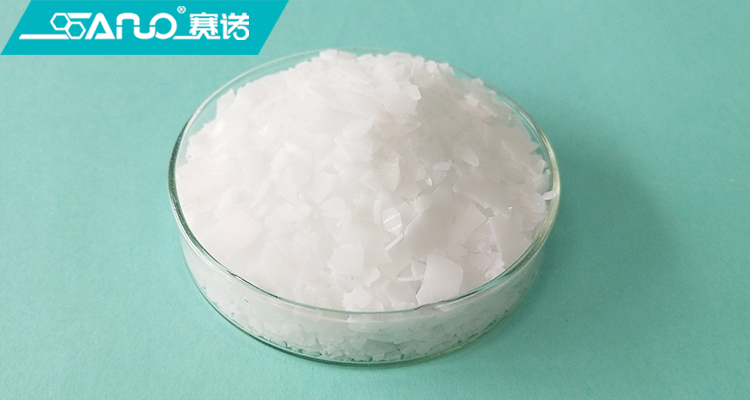Polyethylene wax (PE wax) with high melting pointsand low viscosity are widely used as dispersants or lubricants in plasticsprocessing. This paper classified PE waxes according to synthetic method, chemicalcomposition etc., and discussed their differences in terms of naturalproperties and application in color master batch, PVC, and engineeringplastics.
Sainuo polyethylene wax for color masterbatch has high molecular weight, high viscosity, Both lubricating and dispersing; the dispersion performance is equivalent to BASF A wax and Honeywell AC6A.

Polyethylene wax is divided into many kinds. According to its source, it is divided into polymerization, thermal cracking and by-products. Polymerization polyethylene wax refers to polyethylene wax polymerized with ethylene monomer. According to different polymerization methods, it can be divided into several categories: free radical polymerization, Ziegler Natta polymerization, metallocene catalytic polymerization and proprietary polymerization technology. Thermal cracking method refers to using PE resin as raw material, using screw extrusion or reactor for high-temperature cracking, and cracking polyethylene resin or recycled polyethylene plastic into polyethylene wax with low relative molecular weight. Compared with pe wax of polymerization method, the relative molecular weight distribution is wider, and the taste from low relative molecular weight is difficult to be completely eliminated, and sometimes it is difficult to avoid black spots. The by-product polyethylene wax comes from the by-product of the synthesis of high-density polyethylene resin. It is an oligomer, usually a mixture of oligomers with different polymerization degrees. The quality stability is difficult to control. If the distillation and slitting method is adopted, it can be divided into polyethylene wax with different melting processes.
Polyethylene wax is widely used in plastics, such as pigment dispersant, lubricant for PVC mixture, flow modifier and compatibilizer in PE and PP modifier, etc. In recent years, there are more manufacturers studying and producing polyethylene wax in China, mainly producing polyethylene wax by thermal cracking, cutting the by-product polyethylene wax, compounding packages of various polyethylene waxes, and micronization of polyethylene wax.

1. polyethylene wax is classified according to production method
(1) synthetic polyethylene wax
The polyethylene wax polymerized by high-pressure free radical has a number average relative molecular weight of 1000 ~ 6000, a relative molecular weight distribution of 2 ~ 5, a Brookfield viscosity of 100 ~ 3000cps, a high degree of branching, generally soft and diverse products. It belongs to low-density polyethylene wax, represented by Honeywell’s AC series and BASF luwax.
(2) Pyrolysis polyethylene wax
Polyethylene wax produced by polyethylene resin cracking technology is more domestic and popular in Thailand and South Korea. This wax usually has a Brookfield viscosity of hundreds to more than 1000, such as SCG in Thailand and lion in South Korea. Compared with the synthetic polyethylene wax, this polyethylene wax has wide relative molecular weight, wide viscosity range and medium temperature resistance. It is popular in middle and low-end applications, especially in polyolefin color masterbatch.
(3) By product polyethylene wax
The by-product produced in the process of high-density polyethylene polymerization has a wide melting point range and the viscosity is lower than 0.1pA · s. It usually needs to be cut into products with different melting point ranges before use. The main suppliers are major petrochemical plants.

2. Polyethylene wax is classified according to chemical structure
(1) Homopoly polyethylene wax
Homopoly polyethylene wax is polymerized from ethylene monomer. The physical properties of products are slightly different due to different polymerization processes.
(2) Oxidized polyethylene wax
Oxidized polyethylene wax is obtained after the double bond on polyethylene is oxidized. It is divided into different grades according to the acid value. At the same time, the physical properties of oxidized polyethylene are different due to different polyethylene raw materials. It should be selected according to the specific application in the process of use.
(3) Ethylene vinyl acetate copolymer wax
Ethylene vinyl acetate copolymer wax is synthesized by copolymerization of ethylene monomer and vinyl acetate monomer. It is divided into different brands according to the content of vinyl acetate. Generally, the technology of free radical polymerization is relatively easy to synthesize ethylene vinyl acetate copolymer wax, and the VA content can reach 6% ~ 25%.
(4) Oxidized ethylene vinyl acetate copolymer wax
The double bond on ethylene vinyl acetate copolymer is oxidized to obtain oxidized ethylene vinyl acetate copolymer.
(5) Ethylene acrylic acid copolymer wax
Ethylene acrylic acid copolymer wax is obtained by copolymerization of ethylene and acrylic acid. With the increase of acrylic acid content, the product becomes softer and softer.
(6) Maleic anhydride grafted polyethylene wax
Grafting maleic anhydride on the side chain of polyethylene can greatly enhance the polarity of polyethylene wax, and the grafting rate of maleic anhydride will be much higher than that of maleic anhydride grafted polyethylene resin.
For more details, please consult us! inquiry
Qingdao Sainuo Group. We are manufacturer for PE wax, PP wax, OPE wax, EVA wax, PEMA,EBS,Zinc/Calcium Stearate…. Our products have passed the REACH, ROHS, PAHS, FDA testing.
Sainuo rest assured wax, welcome your inquiry!
E-mail:sales@qdsainuo.com
sales1@qdsainuo.com
sales9@qdsainuo.com
Adress:Biulding No 15,Torch Garden Zhaoshang Wanggu, Torch Road No. 88,Chengyang,Qingdao,China
Post time: Feb-23-2024
